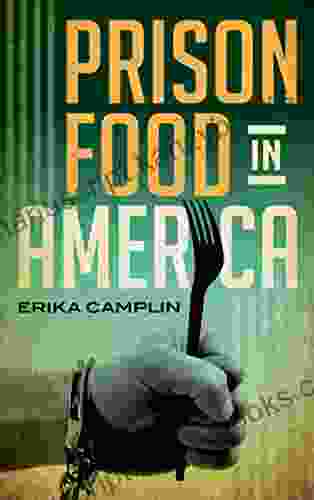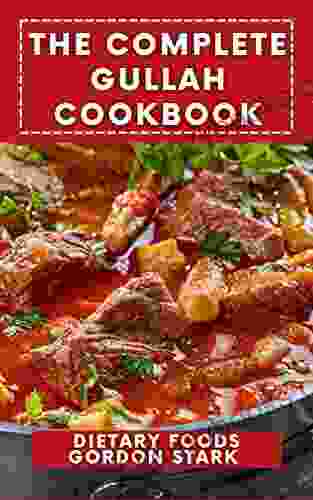Prison Food in America: The Inhumane Reality of Food Insecurity Behind Bars

In the United States, the prison system is the largest provider of food to adults. Every day, over 2.2 million people incarcerated in federal, state, and local prisons are served meals that are often inadequate in quantity, quality, and nutritional value.
This food insecurity has a devastating impact on the health and well-being of incarcerated individuals. Studies have shown that inmates are more likely to suffer from malnutrition, obesity, and chronic diseases such as heart disease, diabetes, and cancer. They are also more likely to experience mental health problems, such as depression and anxiety.
4.4 out of 5
| Language | : | English |
| File size | : | 7068 KB |
| Text-to-Speech | : | Enabled |
| Screen Reader | : | Supported |
| Enhanced typesetting | : | Enabled |
| Word Wise | : | Enabled |
| Print length | : | 140 pages |
The lack of adequate food in prisons is a violation of human rights. The United Nations Declaration of Human Rights states that "everyone has the right to a standard of living adequate for the health and well-being of himself and of his family, including food, clothing, housing and medical care." This right is violated every day in prisons across the United States.
There are a number of factors that contribute to food insecurity in prisons. One is the mass incarceration of poor people. In the United States, the prison population has increased by over 500% since 1970. This increase is due in large part to the war on drugs, which has led to the imprisonment of millions of nonviolent drug offenders.
Another factor that contributes to food insecurity in prisons is the privatization of prison food services. In the 1990s, many states began to privatize their prison food services in an effort to save money. However, private prison food companies have a profit motive, which has led to a decrease in the quality and quantity of food served to inmates.
The lack of adequate food in prisons is a serious problem that needs to be addressed. It is a violation of human rights and it has a devastating impact on the health and well-being of incarcerated individuals. There are a number of things that can be done to address this problem, including increasing funding for prison food services, improving the quality and quantity of food served to inmates, and providing inmates with access to nutrition education and cooking classes.
The History of Prison Food in America
The history of prison food in America is a long and shameful one. In the early days of the American prison system, inmates were often fed nothing more than bread and water. As the prison population grew, so did the need for a more organized system of food service. In the 19th century, prisons began to contract with private companies to provide food for inmates. These companies often provided inmates with low-quality, unpalatable food.
In the 20th century, the prison food system underwent a number of changes. In the 1930s, the federal government began to provide funding for prison food services. This funding helped to improve the quality of food served to inmates. However, in the 1990s, many states began to privatize their prison food services. This led to a decrease in the quality and quantity of food served to inmates.
The Nutritional Value of Prison Food
The nutritional value of prison food varies widely from state to state. However, in general, prison food is low in calories, protein, and essential nutrients. A study by the National Institute of Justice found that the average prison meal contains only about 1,800 calories. This is well below the recommended daily calorie intake for adults. The study also found that prison food is often low in protein, with some meals containing as little as 5 grams of protein.
The lack of adequate nutrition in prison food has a number of negative consequences for inmates. Malnutrition can lead to a variety of health problems, including weight loss, muscle loss, and impaired immune function. It can also increase the risk of chronic diseases, such as heart disease, diabetes, and cancer.
The Cultural Significance of Food in Prison
Food plays an important cultural role in prison. For many inmates, food is a source of comfort and connection. It can help them to cope with the stress and isolation of prison life. Food can also be a way for inmates to express their identity and culture. For example, some inmates may cook traditional dishes from their home countries. Others may use food to create art or to communicate with other inmates.
However, food can also be a source of conflict in prison. Inmates may compete for food, or they may use food to intimidate or control other inmates. Food can also be used as a form of punishment. For example, inmates may be denied food for disciplinary reasons.
The Impact of Food Insecurity on Incarcerated Individuals
Food insecurity has a devastating impact on the health and well-being of incarcerated individuals. Studies have shown that inmates who are food insecure are more likely to suffer from malnutrition, obesity, and chronic diseases. They are also more likely to experience mental health problems, such as depression and anxiety.
Food insecurity can also lead to a number of other problems for inmates. For example, inmates who are food insecure may be more likely to engage in violence or self-harm. They may also be more likely to re-offend after they are released from prison.
What Can Be Done to Address Food Insecurity in Prisons?
There are a number of things that can be done to address food insecurity in prisons. One is to increase funding for prison food services. This would allow prisons to Free Download more food and to improve the quality of the food they serve. Another way to address food insecurity in prisons is to improve the nutritional value of prison food. This could be done by increasing the amount of protein, fruits, and vegetables in prison meals.
In addition to increasing funding and improving the nutritional value of prison food, it is also important to provide inmates with access to nutrition education and cooking classes. This would help inmates to learn how to make healthy choices and to cook nutritious meals. Finally, it is important to address the root causes of food insecurity in prisons. This includes addressing the mass incarceration of poor people and the privatization of prison food services.
Food insecurity is a serious problem in American prisons. It has a devastating impact on the health and well-being of incarcerated individuals. It is a violation of human rights and it needs to be addressed. There are a number of things that can be done to address food insecurity in prisons, including increasing funding for prison food services, improving the nutritional value of prison food, and providing inmates with access to nutrition education and cooking classes. It is also important to address the root causes of food insecurity in prisons, such as the mass incarceration of poor people and the privatization of prison food services.
4.4 out of 5
| Language | : | English |
| File size | : | 7068 KB |
| Text-to-Speech | : | Enabled |
| Screen Reader | : | Supported |
| Enhanced typesetting | : | Enabled |
| Word Wise | : | Enabled |
| Print length | : | 140 pages |
Do you want to contribute by writing guest posts on this blog?
Please contact us and send us a resume of previous articles that you have written.
 Book
Book Novel
Novel Page
Page Chapter
Chapter Text
Text Story
Story Genre
Genre Reader
Reader Library
Library Paperback
Paperback E-book
E-book Magazine
Magazine Newspaper
Newspaper Paragraph
Paragraph Sentence
Sentence Bookmark
Bookmark Shelf
Shelf Glossary
Glossary Bibliography
Bibliography Foreword
Foreword Preface
Preface Synopsis
Synopsis Annotation
Annotation Footnote
Footnote Manuscript
Manuscript Scroll
Scroll Codex
Codex Tome
Tome Bestseller
Bestseller Classics
Classics Library card
Library card Narrative
Narrative Biography
Biography Autobiography
Autobiography Memoir
Memoir Reference
Reference Encyclopedia
Encyclopedia Esther Blum
Esther Blum Ernest A Liner
Ernest A Liner Florian Kugler
Florian Kugler Paul J Krupin
Paul J Krupin Felipe Fernandez Armesto
Felipe Fernandez Armesto Stephen Lewis
Stephen Lewis Sidney Greidanus
Sidney Greidanus Jes Gordon
Jes Gordon Espido Freire
Espido Freire Ted Nugent
Ted Nugent Skye Alexander
Skye Alexander Fazil Jamal
Fazil Jamal Fiona Heggie
Fiona Heggie Fiona Macdonald
Fiona Macdonald Faith Canter
Faith Canter Mark Wright
Mark Wright Eyal Cohen
Eyal Cohen Erin Bower
Erin Bower Winnie Griggs
Winnie Griggs Everett Peacock
Everett Peacock
Light bulbAdvertise smarter! Our strategic ad space ensures maximum exposure. Reserve your spot today!

 Dustin RichardsonGood Food for Simple Gatherings: A Culinary Journey Through the Pacific...
Dustin RichardsonGood Food for Simple Gatherings: A Culinary Journey Through the Pacific... Emanuel BellFollow ·9.5k
Emanuel BellFollow ·9.5k Cooper BellFollow ·11.7k
Cooper BellFollow ·11.7k Jesse BellFollow ·2.7k
Jesse BellFollow ·2.7k Duane KellyFollow ·16.5k
Duane KellyFollow ·16.5k Clark BellFollow ·19.1k
Clark BellFollow ·19.1k Alec HayesFollow ·16.8k
Alec HayesFollow ·16.8k Henry Wadsworth LongfellowFollow ·18k
Henry Wadsworth LongfellowFollow ·18k Sean TurnerFollow ·15.4k
Sean TurnerFollow ·15.4k

 Ivan Turgenev
Ivan TurgenevUnlock Your Thyroid's True Potential: Healing Hashimoto...
The Empowering...

 Patrick Hayes
Patrick HayesBeyond Hot Yoga: Journey into the Depths of Patterns,...
Beyond the sweltering heat of a hot yoga...

 Mike Hayes
Mike HayesFor Dynamic Power Superior Athletic Performance And...
Unleash the Power Within:...

 Jason Reed
Jason ReedUnveiling the Enigma of Glaucoma: A Comprehensive Guide...
Glaucoma, a leading cause of irreversible...

 Michael Chabon
Michael ChabonHebridean Sea Swimmers: Gress Beach
A Journey into...

 Drew Bell
Drew BellJourney to Healing: A Bridge to Hope and Restoration
In the tapestry of life, we encounter...
4.4 out of 5
| Language | : | English |
| File size | : | 7068 KB |
| Text-to-Speech | : | Enabled |
| Screen Reader | : | Supported |
| Enhanced typesetting | : | Enabled |
| Word Wise | : | Enabled |
| Print length | : | 140 pages |










